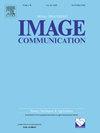SynFlowMap:用于视频运动放大的同步光流重映射
IF 3.4
3区 工程技术
Q2 ENGINEERING, ELECTRICAL & ELECTRONIC
引用次数: 0
摘要
运动放大是指对视频中的微小运动进行空间放大,以揭示场景的重要信息。目前已提出了几种运动放大方法,但大多数方法都会带来可感知的、恼人的视觉伪影。在本文中,我们提出了一种方法,首先分析原始帧和相应帧之间的光流,这些帧是用其他方法进行运动放大的。然后,该方法使用生成的光流图和原始视频合成综合运动放大视频。该方法能以更大的数值放大运动,反转运动方向,并能将来自多个频率和欧拉方法的滤波运动结合起来。除其他优点外,所提出的方法还能消除欧拉运动放大方法造成的伪影。与欧拉方法的主要方法相比,我们对结果进行了广泛的定性和定量分析。这项工作的最后一个贡献是建立了一个新的运动放大视频数据库,可以对定量运动放大进行评估。本文章由计算机程序翻译,如有差异,请以英文原文为准。

SynFlowMap: A synchronized optical flow remapping for video motion magnification
Motion magnification refers to the process of spatially amplifying small movements in a video to reveal important information about a scene. Several motion magnification methods have been proposed, but most of them introduce perceptible and annoying visual artifacts. In this paper, we propose a method that first analyzes the optical flow between the original frame and the corresponding frames, which are motion-magnified with other methods. Then, the method uses the generated optical flow map and the original video to synthesize a combined motion-magnified video. The method is able to amplify the motion by larger values, invert the direction of the motion, and combine filtered motion from multiple frequencies and Eulerian methods. Amongst other advantages, the proposed approach eliminates artifacts caused by Eulerian motion-magnification methods. We present an extensive qualitative and quantitative analysis of the results compared to the main approaches for Eulerian methods. A final contribution of this work is a new video database for motion magnification that allows the evaluation of quantitative motion magnification.
求助全文
通过发布文献求助,成功后即可免费获取论文全文。
去求助
来源期刊

Signal Processing-Image Communication
工程技术-工程:电子与电气
CiteScore
8.40
自引率
2.90%
发文量
138
审稿时长
5.2 months
期刊介绍:
Signal Processing: Image Communication is an international journal for the development of the theory and practice of image communication. Its primary objectives are the following:
To present a forum for the advancement of theory and practice of image communication.
To stimulate cross-fertilization between areas similar in nature which have traditionally been separated, for example, various aspects of visual communications and information systems.
To contribute to a rapid information exchange between the industrial and academic environments.
The editorial policy and the technical content of the journal are the responsibility of the Editor-in-Chief, the Area Editors and the Advisory Editors. The Journal is self-supporting from subscription income and contains a minimum amount of advertisements. Advertisements are subject to the prior approval of the Editor-in-Chief. The journal welcomes contributions from every country in the world.
Signal Processing: Image Communication publishes articles relating to aspects of the design, implementation and use of image communication systems. The journal features original research work, tutorial and review articles, and accounts of practical developments.
Subjects of interest include image/video coding, 3D video representations and compression, 3D graphics and animation compression, HDTV and 3DTV systems, video adaptation, video over IP, peer-to-peer video networking, interactive visual communication, multi-user video conferencing, wireless video broadcasting and communication, visual surveillance, 2D and 3D image/video quality measures, pre/post processing, video restoration and super-resolution, multi-camera video analysis, motion analysis, content-based image/video indexing and retrieval, face and gesture processing, video synthesis, 2D and 3D image/video acquisition and display technologies, architectures for image/video processing and communication.
 求助内容:
求助内容: 应助结果提醒方式:
应助结果提醒方式:


